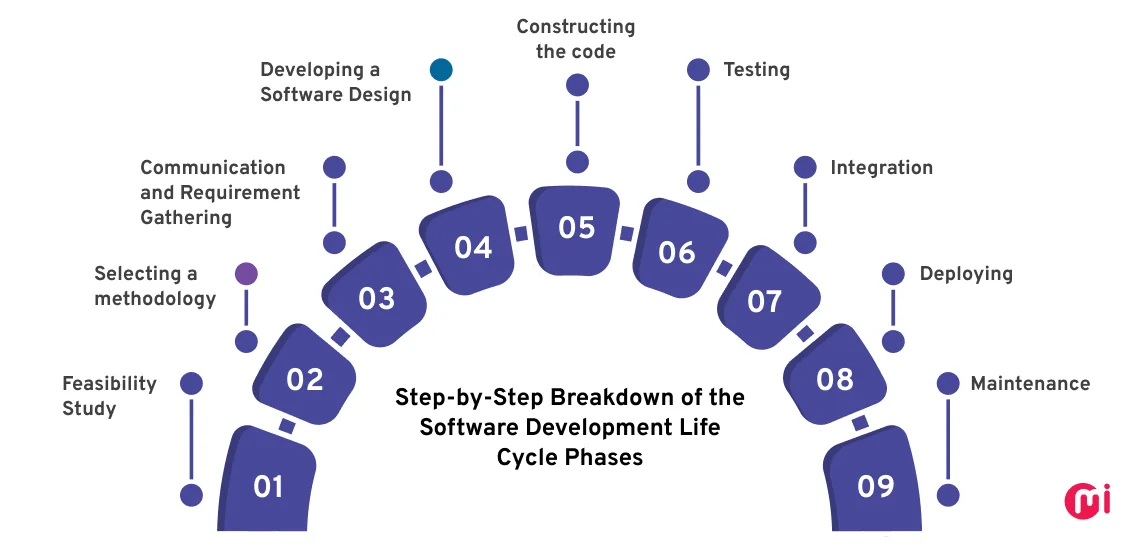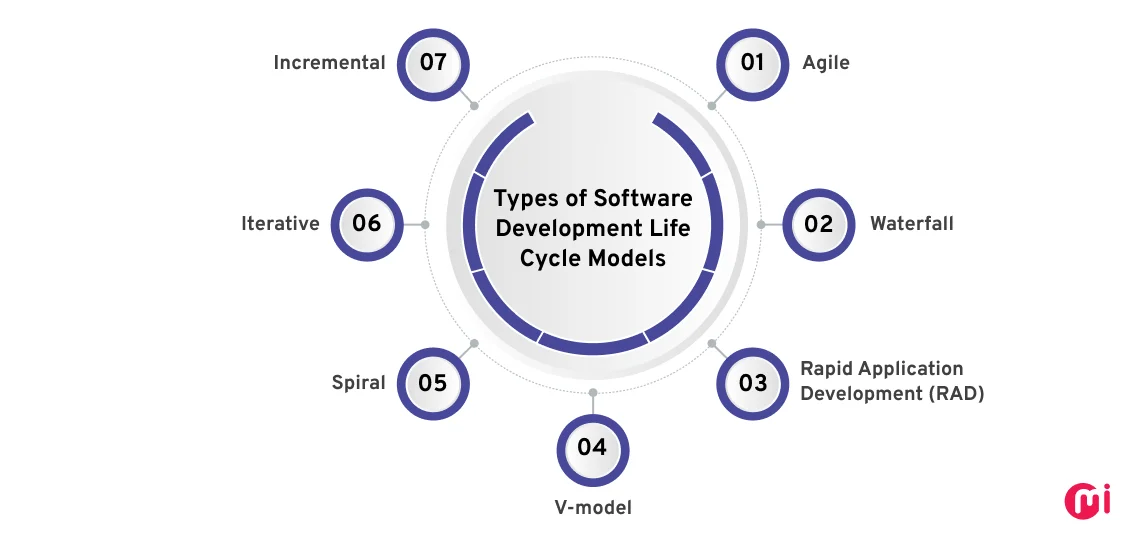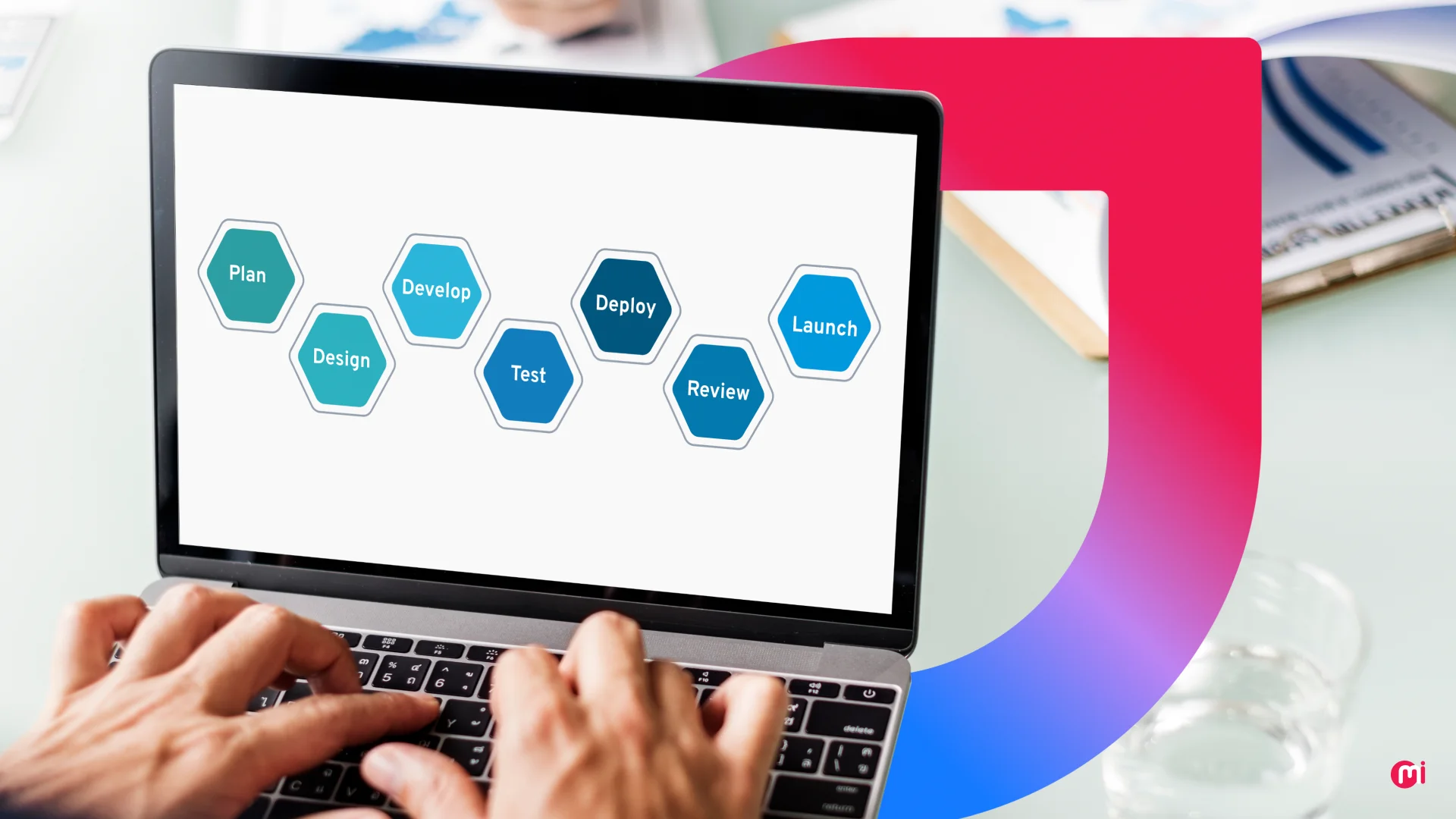Software Development Life Cycle (SDLC): Phases, Types and Benefits
- Software
- October 3, 2024
Maximizing efficiency in software development projects is what most business leaders seek, which is why over 94% of organizations practice Agile. Adopting a systematic development approach like a software development life cycle can drive the efficiency you are striving for. Read the full blog post to gain insights into how this approach benefits your development process, the phases of the SDLC, various SDLC models, when to choose which model, and more.
What is Software Development Life Cycle (SDLC)?
Software Development Life Cycle (SDLC) is a structured approach used by software development companies to plan, develop, test, and deploy high-quality software. It enables software development teams to develop software that meets customer requirements and user expectations while avoiding pitfalls that increase the risk of project failure, even as needs evolve and market scenarios change.
What sets the SDLC apart is its ability to be both cost-effective and time-efficient. By following a clear, step-by-step approach, the SDLC helps teams avoid costly mistakes and rework, ensuring software projects stay on schedule and within specified budget.
By dividing the Software Development Life Cycle into phases such as planning, design, development, testing, deployment, and maintenance, the SDLC ensures that software is developed systematically. It provides complete visibility and control over the entire software development process.
Discover the latest trends and insights in software development by exploring our detailed blog on software development statistics.
Key Benefits of Software Development Life Cycle
Understanding the advantages of the SDLC is essential for anyone involved in software development, as it lays the foundation for delivering reliable and scalable software solutions. Let’s explore the benefits of the Software Development Life Cycle process in detail.
1. Systematic approach to development
A systematic approach means better organization of tasks, effective allocation of resources, and improved management of project timelines.
It leads to a more controlled development environment, increasing the likelihood of meeting project goals within budget and on schedule—without compromising quality in any aspect of development.
2. Faster time to market
Having a structured framework allows the project to be broken down into distinct phases (which we will explore further in this blog). This approach increases efficiency, minimizes delays, and ensures timely product delivery.
A faster time to market enables businesses to capitalize on emerging opportunities, gain a competitive edge, and meet market demands more promptly.
3. Clear guidelines for developers
A well-defined software development lifecycle process outlines the specific tasks, responsibilities, deliverables, timelines, and more for every stage of the development process.
This ensures that software developers have a clear roadmap of what needs to be done and when minimizing misunderstandings and miscommunications. The result is fewer revisions, reduced errors, consistent quality maintenance of the digital product, and ultimately, cost and time savings.
4. Improved Transparency in the development process
Apart from clear milestones and deliverables, the SDLC often involves using project management and visualization tools, enabling stakeholders, including customers and investors, to receive real-time updates on project status.
Regular communication and collaboration for reporting and updates further ensure that everyone involved not only stays informed but can also assess performance against milestones and make informed decisions.
5. Improved risk management
Risk management practices are implemented in every phase of the software development life cycle. Each phase involves specific activities and deliverables, providing opportunities to identify potential risks before they escalate and become costly.
The ability to detect risks early allows the team to develop mitigation strategies to address critical threats. Additionally, it enables developers to create a contingency plan.
Want to transform your business growth with software development, but don’t know how? Read blog to know the benefits of software development consultancy for your business.
Software Development Life Cycle Phases
As we know, the SDLC is a structured approach comprising a bifurcated software development process. Here are Software Development Life Cycle phases to better navigate the complexities of software development projects:

1. Feasibility Study
In this phase, the project’s viability is assessed. A feasibility study is conducted to evaluate the practicality of the project by examining its technical, financial, and operational aspects.
For instance, evaluating the availability of resources and technology, analyzing the project’s cost-benefit ratio, assessing the project’s alignment with organizational goals, and more.
The outcome of feasibility study helps determine whether to proceed with the project, adjust its scope, or abandon the initiative. This stage is also know as discovery phase of software development.
2. Selecting a methodology
This phase of the software development life cycle involves choosing a suitable SDLC model based on the software development project requirements. Common SDLC methodologies include Waterfall, Agile, and more.
For instance, if your project is complex with uncertain requirements, like developing a mobile software solution that needs to adapt to changing user feedback, Agile might be the best choice. Conversely, for well-defined projects with minimal changes, such as developing regulatory compliance software, Waterfall could be a suitable software development methodology.
The selected software development methodology will guide the entire development process, influencing how the team handles tasks, timelines, level of flexibility, and deliverables.
3. Communication and Requirement Gathering
This phase involves engaging with customers through interviews, workshops, surveys, and other methods to understand their needs and expectations. The goal is to define the scope of the project and gather all necessary requirements that the software solution must fulfil.
Additionally, clear and thorough documentation is created based on the gathered information to ensure that everyone has a shared understanding of the project’s objectives, functional requirements, and technical specifications.
4. Developing a Software Design
In this phase, the software’s architecture and design are developed. The software development team creates data models, designs the user interfaces, details the overall software structure, and more. This software design serves as a blueprint for the software development team, guiding them in developing the software.
5. Writing the code
This is the phase where developers write the actual code using the appropriate tech stack, programming languages, frameworks, tools, and more, to implement the software design.
Along with the technology stack, developers follow the design specifications while coding the software. They work on building the frontend, backend, APIs, and other components.
6. Testing
Software testing is one of the most critical phases of Software Development Life Cycle as it ensures the software’s quality. After the code is constructed, it undergoes rigorous software testing to identify and fix any bugs or issues.
Various software testing methods, such as functional testing, performance testing, regression testing, and more, are employed by QA engineers to ensure the system functions as expected and meets the requirements. It also ensures that the software performs well under different conditions.
7. Integration
In the integration phase, different modules and components of the software are developed during the coding phase are combined into a unified system. This software integration step ensures that all parts of the system work together seamlessly.
For example, a dedicated developer might integrate a payment gateway module into an eCommerce platform to enable online transactions or connect a CRM system with an existing email marketing platform to automate customer communication and lead nurturing.
Integration testing is conducted to verify that the newly integrated features meet the overall design specifications and do not disrupt existing functionalities.
8. Deploying
Once the system has been fully tested and integrated, it is deployed to production making it available for customer use.
Deployment involves installing the software on servers, configuring the system, making it accessible to end-users, and possibly migrating data from legacy systems, if applicable.
9. Maintenance
The final phase of the SDLC in software development is maintenance, which involves ongoing support and updates to the software.
Maintenance activities include fixing bugs, updating the software to adapt to new requirements, adding new features, optimizing performance, implementing security patches, and ensuring the system continues to function as intended.
Regular maintenance ensures that the system operates efficiently and effectively for the longest time.

Types of Software Development Life Cycle Models
Each project is unique, and so are the software development process requirements. This is why there are various software development life cycle models available, each offering a range of methodologies that you can adopt according to your specific needs and project constraints.
Here are some of the popular software development life cycle models:

1. Agile
Agile is an SDLC methodology that enables the development team to break down their project into small, manageable units called sprints. Agile methodology is characterized by its iterative and incremental approach, which emphasizes collaboration, flexibility to adapt, and customer feedback.
When to use Agile:
- Suitable for projects where the requirements changes frequently based on customer feedback or market conditions.
- When a project requires frequent updates and rapid delivery of new features.
- Best suited for projects where team members need to work closely with customers and adapt to changes dynamically.
2. Waterfall
Waterfall model is a linear and sequential approach where developers can move to the next phase of development only upon completing the current phase.
When to use Waterfall:
- Ideal for development projects with clear and fixed requirements that are unlikely to change.
- Suitable for small projects with a fixed scope that does not need to adapt to new or evolving requirements.
- Best for projects where both the technology and the environment are stable and well-understood.
3. Rapid Application Development (RAD)
The RAD model emphasizes rapid prototyping and iterative development rather than extensive planning. This means that development teams work on creating prototypes early in the software development process to gather feedback and then make adjustments to the prototypes before further developing the software.
When to use RAD:
- Ideal for projects where time-to-market is crucial and quicker development cycles are needed.
- When requirements are not fully defined at the start, iterative feedback is necessary to refine the product.
- For projects where user feedback is critical for improving the final product and guiding further development.
4. V-model
V-model is also known as the Verification or Validation model, this model is an extension of the Waterfall model. Unlike the Waterfall model, which is linear, the V-Model follows a V-shaped approach, emphasizing parallel testing phases for each development stage. It ensures that each development phase is validated against requirements and verified through corresponding testing.
When to use the V-Model:
- Ideal for projects where quality assurance is a critical factor.
- Best for projects that have well-defined requirements and need rigorous testing and validation.
5. Spiral
This model involves repeating cycles or spirals, which combine iterative development with the Waterfall model to enhance risk management (its primary focus).
When to use the Spiral Model:
- Ideal for complex and large-scale projects where risk management and iterative refinement are crucial.
- Useful when requirements are expected to change over time, allowing for iterative adjustments and refinements.
6. Iterative
Derived from the word “iteration,” this model involves repeated cycles of development, testing, and evaluation. With each iteration, the development team can improve and refine the software version based on customer feedback.
When to use the Iterative Model:
- Ideal for projects where incremental improvements and refinements are needed.
- Suitable for projects where requirements are not fully defined at the start and may evolve as development progresses.
- Useful when frequent feedback from users is needed to guide the development process and make adjustments.
7. Incremental
The Incremental model involves building the software in small, manageable increments or segments. Each increment adds new functionality to the existing system, allowing for partial deployment and use.
When to use the Incremental Model:
- Ideal for projects where the software can be developed in distinct, functional modules or components.
- Suitable for projects where early delivery of functional parts is beneficial, allowing users to start using parts of the system before the full system is completed.
- Useful for large-scale projects with complex requirements, where delivering the system incrementally helps manage and control scope and resources.
Software Development Excellence: The MindInventory Way
At MindInventory, we are at the forefront of software development and technology innovation. We offer a wide range of custom software development services, including startup software development, enterprise software development, software product development, and more.
With years of industry experience, we offer skilled software developers for hire who possess the technical expertise, awareness of current software development trends, and proficiency needed to deliver cutting-edge and reliable software solutions. We are committed to pushing the boundaries of technology to deliver innovative solutions that drive success.
We have assisted businesses across industries in developing their software and driving their businesses forward. If you are looking for a strategic partner to achieve software development excellence, reach out to us today to discuss how MindInventory can help you achieve your software development goals.
FAQs on the Software Development Life Cycle
The simplest way to highlight the difference between these two terms is that the software development process focuses on the “how” of development, while the SDLC outlines the “what” and “when” of development stages. Both concepts are crucial for successful software development but operate at different levels of abstraction.
Although the SDLC is widely popular and its models are widely adopted, there are some possible drawbacks associated with it. These include rigidity, slow adaptation, risk of misalignment with user needs, limited flexibility in some models, extensive documentation, difficulty in managing changes, increased complexity, and more.













